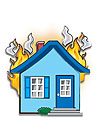
Conventional wisdom tells us that the current state of fire protection engineering technology is fairly advanced and getting better all the time. But the fact remains that the number of fire sprinkler systems inside structures worldwide, and public knowledge regarding the substantial advantages of fire sprinkler systems, is still in its infancy.
There is work to be done for those employed in the fire sprinkler industry and this includes the promotion of fire sprinklers. Fires wreak havoc every day, but one thing history has demonstrated is that in every crisis there is opportunity. So efforts need to be carefully orchestrated in order to achieve new legislation regarding sprinklers in high-rise buildings, nursing homes, daycare centers, hospitals, new homes and college dormitories.
This is not to say that the overall efforts of those in the business of fire protection in recent years have not had a positive impact. The table below illustrates the dramatic impact that an increased focus on fire protection and life safety have had on annual U.S. fire deaths.
Fires in 2006 accounted for 3,245 civilian fire deaths, a decrease of 12 percent over 2005. Of that total, 2,580 fatalities (just under 80 percent) occurred in the home - 425 perishing in apartment fires and 2,155 in typical dwellings. It is alarming to note that 45 percent of last year’s civilian fire deaths occurred in communities with a population below 5,000. Older or otherwise substandard rural housing remains a real 24/7 threat to all who combat fire.
All told, a residential fire occurs every 76 seconds in this country. Ninety percent of fire injuries suffered in structure fires in 2006 occurred in residential properties.
Some in society are more vulnerable than others and that includes children, the handicapped and the elderly. Also, alcoholics are 10 times more likely than nonalcoholics to die from fire. Half of all fire fatalities result from fires that start between 10 p.m. and 6 a.m. Fire fatalities peak in January, and rank second in February and third in December. The percentage by which the number of home fires in the United States on Thanksgiving Day exceeds the national average is 32 percent.
Fire safety education, escape plan reminders, smoke detectors and a more widespread adoption of residential sprinkler ordinances must be part of the public consciousness in order to generate a further decrease in fire injuries, burns and fatalities. I was born in the Eisenhower years, when nobody owned a house equipped with fire sprinklers. But no one had a house equipped with smoke detectors either, for that matter, or a car containing seat belts. Now it’s the law. What took so long?
What is it going to take to keep fatalities and risk factors going down? One sure way to continue the trend is to tirelessly go after the “big fish.” The magnitude of arson activity jumps out when reviewing any fire statistic, and remains an awful menace. Roughly 31,000 structure fires in 2006 were intentionally set (a decrease of 1.6 percent), and those resulted in 305 deaths. As grim as this sounds, fatalities resulting from these types of fires averaged 694 annually during the 20-year span from 1977 to 1996. Arson remains the second-leading cause of residential fire deaths in this country.
Certain cities are more at risk - arson accounted for 46 percent of fire fatalities in Detroit last year, and 25 percent in Dallas and New York City. Currently, one-fourth of all residential fires in Los Angeles and Cleveland are intentionally set. Just 15 percent of arson cases are closed by arrest.
Fires occur daily in this country. Fire is a living, breathing, moving thing. Firefighters know that if they don’t hustle to get it, it will come and get them. Their No. 1 priority is to get the wet stuff on the red stuff. For those in the practice of installing fire sprinkler systems, their key to success is establishing the correct priorities: Get the design right, make sure all hydraulic calculations are accurate, protect the potential (worst-case) hazard and completely sprinkler the buildings.
Likewise for those reviewing plans: Don’t sweat the small stuff, but sweat heavily on the important stuff, such as double-checking the water supply, the occupancy and the hydraulics. After performing hand-calculations for 25-plus years, I find inaccuracies with submitted computer-generated calculations on more than half the projects I review. Some are just glaring omissions. And I have seen reviewers completely miss calculation errors, while failing a plan submittal for a variety of painfully inconsequential reasons.
That’s as atrocious as being a lazy inspector. But the most important thing for any building owner, particularly one in which large numbers of people congregate, is to actually have a fire sprinkler system - ideally a wet-pipe system comprised of steel pipe, properly alarmed and complete with at least two check valves and a fire department connection. And in a perfect scenario, the afore-mentioned designers, installers and reviewers will be licensed individuals.
I believe in the integrity of properly installed fire sprinklers and the capabilities of the people in the fire protection industry. After all these years in the business, I am not without opinion. The fact that there are so many unsprinklered properties in this country is simply unsafe, and the United States continues to have one of the highest per capita fire-related death rates in the world. The cause is not only fire, but also politically driven code management and overall public apathy.
Promotion is paramount, and acceptance is necessary. When the general public takes us seriously 100 percent of the time, we are all going to reap the benefits of that amenability. Comprehensive fire safety happens to be something very attainable.